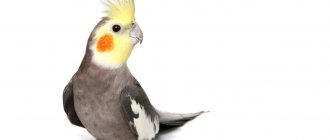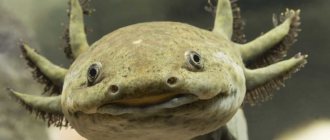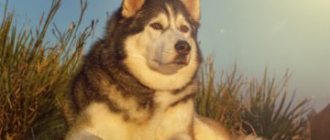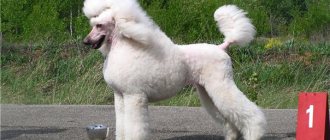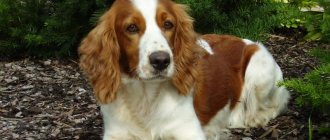Corella parrot: description
Corella parrots have become known to lovers of our country quite recently. Despite this fact, these exotic birds are characterized as quite smart, original and low-problem in keeping.
Intelligence
These birds are deservedly included in the top ten most intelligent birds, which makes it possible to keep them in human conditions without any problems. As the experimental results show, the level of intelligence of this bird is comparable to the level of intelligence of a 5-year-old child.
Appearance and colors
Adult birds of this species grow up to 33 cm including the tail. The tail is quite long and pointed, and the head has a rather high crest. At the same time, the plumage of females and males has differences. Males are characterized by the presence of a brighter, defiant olive-gray shade, while the crest and head are distinguished by the presence of a yellow tint. The wings are more colored in velvet-black tones, with the presence of a bluish or silver color.
Interesting fact! The beak of this bird, both in appearance and in shape, is more reminiscent of the beak of a cockatoo, but at the same time does not differ in size, since it is significantly smaller in size. Despite this, the bird's beak is quite powerful and sharp, since the bird is able to bite through wire, such as electrical wiring.
As for the females, they are characterized by a dirty gray coloring of the main plumage, as well as the presence of a brownish tint on the underside of the body, while the cheeks are painted with spots of a pale brown tint. The head and the crest itself are pale gray with the presence of light yellow tones. The fact that young birds are more similar in color to females is considered characteristic. In this regard, only after a year can the gender of the birds be determined.
Subspecies of Corella parrot
Due to the fact that breeding such birds in captivity is simple, as a result of the work of specialists it was possible to obtain various shades of the birds’ plumage, which further complicated the process of determining the sex of the Corella parrot. The most famous subspecies are:
- The albino cockatiel is a bird with white or cream colored plumage with red eyes. This is due to the complete absence of coloring pigment. The head and crest are distinguished by their yellow color. The female may have pale yellow spots on her wings.
- The cockatiel is white with black eyes, the result of crossing a white female and a gray male. Males of this subspecies are distinguished by the presence of white feathers in the tail, while in females this part is marbled.
- The Lutino Corella is a yellow parrot with red eyes. On the sides of the head, regardless of gender, you can see characteristic bright orange spots.
- The cockatiel is light gray with black eyes. The subspecies was created by crossing a gray and a white parrot. The subspecies is distinguished by the presence of light gray shades in the tail.
- The cockatiel is dark yellowish , although there are subspecies with many variations of similar shades, ranging from dark yellowish to light cream.
Recently, the Corella Sheki bird has appeared, which is characterized by the presence of heterogeneous white spots on its plumage. Many experts believe that this subspecies can serve as a good basis for breeding new subspecies that are very original in color.
Interesting to know! The Sheki subspecies has quite interesting color variations: they can be pearl-gray, white-winged and black-winged, including a black-gray shade with a pure black chest.
Corella - All about the parrot species | Parrot species - Corella
Natural habitats
Being in their natural environment, these birds for their livelihoods choose forest plantations located in the coastal zone of reservoirs, as well as eucalyptus groves and thickets of shrubs located in the savannah. Numerous flocks can be seen on the tops of dried trees, as well as on tall bushes. The most numerous populations are observed in Australia.
Minuses
What kind of trouble can you expect from a cockatiel?
- Cute parrots have a deceptive appearance: they are often aggressive, attack other birds, and bite people.
- If you dream of a talking parrot, this bird is not for you. It will take a lot of effort to teach her a few words.
- The nymph is famous for its harsh, unpleasant voice. She is also very noisy and cannot be silenced.
- Maintaining cleanliness in the house where the cockatiel lives is quite difficult: it does not know how to eat neatly, and often defecates. In addition, during the molting period, there will be fallen feathers everywhere, and then peeled shells of new feathers.
- Loves to chew on surrounding objects. Objects for study and destruction can be wires, computer keyboards, books, and money. A bird left unattended can damage equipment and furniture, and can injure itself.
Keeping a Corella parrot at home
There are no difficulties in keeping a Corella parrot at home, so this process is accessible even to inexperienced lovers of keeping birds at home. Still, certain rules must be followed.
Cage structure
This bird likes its conditions to be as free as possible, so it will not feel comfortable in a cramped cage. In this case, you should pay attention to cells measuring 60x60 or 70x70 centimeters at least. At the same time, the door must be of such a size that the bird can freely fly out of the cage and return back.
Important to remember! Experienced bird owners recommend purchasing a cage that has larger vertical than horizontal dimensions. A cage of 60x50x50 cm is suitable for keeping one bird, and a rectangular cage with dimensions of 150x70x70 centimeters is suitable for two birds.
The cage is made of metal wire, but it should not have a paint coating. A retractable tray should be provided at the bottom of the cage. To avoid scattering of feed and splashing of water, some kind of sides should be built in the lower part, possibly made of plastic. The cage should be equipped with several perches, a feeder, a water container, and several toys.
Care and hygiene
Firstly, you need to choose the right place for the birds, since they are quite heat-loving birds. It is believed that they do not tolerate temperature changes well. As a result, the parrot may get sick or even die. Therefore, you should think about ensuring that there is no draft in the place where the birds are located, and the air temperature should be at the optimal level.
Interesting fact! According to the owners of Corella parrots, these birds are quite susceptible to foreign odors in the room, such as cigarette smoke, perfumes, disinfectants containing chlorine, including air fresheners.
The most optimal temperature for keeping a Corella parrot is from 22 to 24 degrees Celsius. There is one more factor to pay attention to. When heating devices are turned on in winter, a decrease in air humidity is observed in a person’s home, which negatively affects the health of birds. You always need to ensure that the filler in the cage is changed regularly, and that drinkers, feeders and all toys are washed once a week.
What to feed your cockatiel parrot
The well-being of birds, as well as their health and, ultimately, the life expectancy of pets depends on proper, healthy nutrition. This definition is considered relevant not only in relation to the content of the Corella parrot.
Important to remember! According to experts, high-quality and balanced foods, such as Vitacraft for Corella, Padovan, Prestige, and Vaca, are considered the most suitable.
In any case, preference should be given to purchased, ready-made, complete food. Birds don't eat much, so don't skimp on their health. At the same time, you should know that the basis of any feed, regardless of its cost, is: millet, oats, wheat, sunflower and corn. If the food is more expensive, then nuts, minerals, oils and yeast are also added to it.
Lifespan
Living in natural conditions, these birds rarely live to be ten years old, since they constantly have to look for food for themselves, putting their lives in danger.
If you keep a parrot in artificial conditions, following all the rules of keeping, then the pet can live for almost 20 years, or even more, as evidenced.
Poultry diseases and their prevention
In case of illness, the bird’s behavior changes, and the following symptoms may appear:
- Difficulty or rapid breathing.
- Inflammation of the skin.
- Baldness.
- The appearance of growths or detachments on the beak.
- Vomit.
- Diarrhea or constipation.
It is believed that the most common are plumage problems associated with improper molting process, as well as self-plucking.
The appearance of problems with the gastrointestinal tract, expressed by gastroenteritis and dysbacteriosis, is also considered not uncommon. As you know, it is easier to prevent diseases than to treat them later. Therefore, the best way to combat diseases is their prevention, which consists of properly keeping the parrot and providing it with a balanced diet. Regular visits to the veterinarian won't hurt.
Is it possible to teach a cockatiel to talk?
Many people are interested in the question of whether a Corella parrot can be taught to speak. Compared to budgies, which are considered more "talkative", the Corella parrot can pronounce words more clearly and more intelligibly. Almost every representative of this family has the ability to imitate human speech. If you regularly work with your parrot, he can learn to “pronounce” individual words and even entire sentences. In addition, the bird is able to remember other sounds, for example, simple melodies.
Interesting fact! The Corella parrot has a rather sharp and shrill voice, which leads to the distortion of spoken words, as well as the accompaniment of speech by melodic sounds made by the parrot. Therefore, we can say that the parrot has its own, very impressive vocabulary.
HOW TO TEACH A PARROT TO TALK / My experience and successes with CORRELLA
Diet
The cockatiel menu should be as close to natural as possible. This means that the diet should be dominated by:
Grain feed (millet, hemp seed, oats, corn, canary grass). The average rate of grain feed is 1.5-2 tablespoons daily. The last number is for a large parrot.
Vegetables (cucumbers, carrots, Brussels sprouts).
Fruits (Plums, apples, peaches, pears, cherry plums). The parrot is partial to these fruits.
In small quantities, you can add wheat grains, sunflower seeds, nuts and legumes soaked in water. Sometimes you can gradually give animal products - boiled eggs and low-fat cottage cheese. Birds especially need animal protein during nesting.
Prohibited Products
The list of foods that cockatiels should not eat includes:
- Candied fruits.
- Seeds of stone fruit crops.
- Hot peppers.
- Milk, cheese, butter, sour cream.
- Spices.
- Potato.
- Mushrooms.
- Branches of conifers, oak, viburnum, pear, lilac, poplar.
- Sorrel and rhubarb.
Tips for buying a parrot
When choosing a parrot in a nursery or elsewhere, the sex of the bird can be determined by its color and behavior. As a rule, before 1 year of life, it is very difficult to do this without being a specialist. In this case, it is necessary to take into account that males are noisier, often knock with their beaks, and also make more complex sounds.
Where to buy and what to look for
The Corella parrot can be purchased both in a nursery and from a private breeder. If the parrot is healthy, it has a beautiful and neat appearance, with even plumage that fits tightly to the body, clear eyes and an excellent appetite. The bird is quite active and “verbose”.
If a parrot nervously rushes around in the cage, screams loudly, scratches itself or pulls out feathers, then this is the first sign that something is wrong with the parrot and you should absolutely not buy it. You cannot buy very apathetic individuals, depressed, ruffled, losing coordination or falling over on their side.
Corella parrot price
Australia is considered the homeland of Corella parrots and their export from the country is prohibited by law, so only birds artificially bred in nurseries or from private breeders are sold. The cost of a parrot is not exorbitant, but quite affordable, due to the simple breeding process. For a parrot, 3 months old, you will have to pay an average of 3 thousand rubles.
Diseases and their treatment
Corella parrots are susceptible to a fairly large number of different diseases. Therefore, if you notice that your feathered pet has begun to breathe heavily, has signs of diarrhea, has stopped eating, or has started to lose feathers, it is recommended that you immediately contact your veterinarian. This is very important, since it is simply impossible to make a diagnosis on your own, much less choose the appropriate treatment.
The most common diseases are:
- Conjunctivitis. For treatment, use “Furacilin”, one tablet of which is diluted in a glass of warm water, and the eyes are washed with the solution.
- A goiter disease that occurs due to poor nutrition and is accompanied by a disorder of the digestive system. In this case, the bird is given activated carbon, which helps remove toxins from the body.
- Feather loss typically occurs every 6 months. This is a planned molt. Therefore, there is no need to worry. But if at the same time wounds appear on the parrot’s body, then the reason is most likely parasites, which can be gotten rid of with the help of special ointments.
- If your pet refuses to eat and there is discharge coming out of his nose, then this is a sign of a cold. In order for the bird to recover quickly, it is necessary to place the cage with it in a warm place, protected from drafts, and also provide good nutrition, rich in vitamins.
It is worth noting that if any symptoms appear, it is recommended to immediately contact a veterinarian.
Owner reviews
Corella parrots are very popular among our lovers of domestic ornamental birds. The fact is that a parrot is easily tamed, and can also easily learn both individual words and entire phrases. But at the same time, it should be noted that the bird’s ability to reproduce various sounds that are not typical for a parrot is quite limited.
Important to remember! The Corella parrot should never be teased, as when angry it makes very unpleasant sounds, and quite loud ones at that.
For the sake of fairness, it should be noted that the parrot makes mostly monotonous and very annoying sounds, sometimes grating on the ears. Males sing well, imitating various sounds, as well as the singing of other birds, such as a nightingale or titmouse. Many owners claim that the parrot simply begs for pieces of food from the table and is able to open the lock on the cage when no one is home.
Disadvantages of KEEPING A Cockatiel Parrot. Are you ready for this?
Where to keep it?
Their playful nature will help you understand how to tame a cockatiel parrot. Bright birds are lovers of toys, so when choosing an aviary, it is worth considering this feature of birds. Due to their peaceful nature, cockatiels can safely live with each other in a 100x40x60 cage. The main nuance is the environmental friendliness of the selected materials. Wooden rods should not be taken into account - the mobile and powerful beak of cockatiels will destroy this obstacle.
The bars of an enclosure or cage should be positioned strictly horizontally, since mischievous people also like to climb the bars with a song at the ready. Toys or other accessories should be stirred evenly, but care must be taken that they do not interfere with their free movement.
An abundance of toys is not the best option for a cockatiel; the correct tactic for living with parrots of their species would be to constantly alternate the arsenal of entertainment, as well as install ropes.
Appearance
In appearance, the nymph parrot belongs to the subgroup of flat-tailed birds. The rounded beak is very active and large, unlike other representatives of birds. The four-toed paws are usually directed in different directions. This natural characteristic is required for dexterous movement along tree branches and convenient capture of food. A special feature is the elongated shape of the plumage on the back of the head.
Education
One of the hallmarks of cockatiels is their tendency to learn. Young individuals aged 12–14 weeks are especially successful in training. Their older relatives are more likely to show caution, which somewhat slows down the process of mastering skills, but does not make it ineffective. Such birds need a patient attitude and time.
Ornithologists advise choosing one family member to practice with a cockatiel. Training should be short but daily. The more a bird gets used to communicating with people, the easier it is to train it. It is believed that before starting training, it is necessary to carry out such a painless procedure for the bird as trimming the wings. The cockatiel can be toilet trained, perform the commands “can”, “can’t”, “forward”, “back” and some other simple actions, as well as imitate the sounds of human speech, that is, talk.
Parrots are beautiful and intelligent creatures. Caring for cockatiels is not difficult. It is not surprising that many bird lovers prefer them. Even novice poultry keepers can easily care for a cockatiel.
Bird care
One of the main responsibilities of a cockatiel owner is caring for the bird. It is as follows:
- feeding your pet healthy food;
- ensuring constant access to clean water;
- communication with birds;
- observing the psychological state of the bird, normally it should not bite or show other signs of aggressive behavior;
- maintaining the health of the parrot, identifying symptoms of diseases, and regular visits to the veterinarian.
Spreading
Australia is named as the birthplace of the nymph breed. They live in grassy areas with trees and shrubs spaced apart from each other. Parrots were found on plains along river banks and semi-deserts. They like to move in small groups of 20-50 birds, if not during the breeding season. In regions of severe drought, they accumulate in large flocks near water bodies at a safe distance.
Despite free breeding in captivity and easy adaptation to the human environment, Australian legislation prohibits the export of the Corella breed outside the country. However, there are also tame parrots; they adapt well to an unusual place and, under proper conditions, live from 15 to 25 years.
Singing
Both in natural and at home conditions, the cockatiel sings very melodiously, accurately repeating the sounds it hears. Nymphs easily copy the sounds of alarm clocks, household appliances and other pets. But teaching them to talk is a little more difficult. To do this, you need to show self-control and patience.
Male cockatiels sing especially beautifully during the mating season. At this point, it is easiest to teach the cockatiel to repeat sounds, as well as melodies. To do this, you should hum or whistle simple songs several times a day.
Interesting Facts
Photo of a cockatiel on a cage
There are several interesting facts that colorfully characterize cockatiels:
- The nymph's intelligence is identical to the mental development of a 3-4 year old child.
- A parrot raised in captivity becomes completely tame, considering a person a member of its family.
- In the wild, a cockatiel sitting on the ground will not allow a person to approach it, but when it is on the branches of trees, it can safely allow people to touch it.
- Nymphs recognize about one and a half hundred different images per second, while humans recognize only 16.
- There are schools in Australia that teach cockatiels and other parrots to talk.
- Nymphs do not have vocal cords, and they produce sounds only with their mouths.
- Depending on which paw the cockatiel takes food with, it can be considered right-handed or left-handed.
Emotional impact
Being sociable birds, parrots require attention from their owners. You need to communicate with them regularly, talk, play. Otherwise, they may become depressed or aggressive.
For a bird to develop fully, it needs free flights. Corellas love to walk on the floor and sit with people on the sofa or armchair. When moving around the house, you need to be careful not to accidentally harm your pet.
